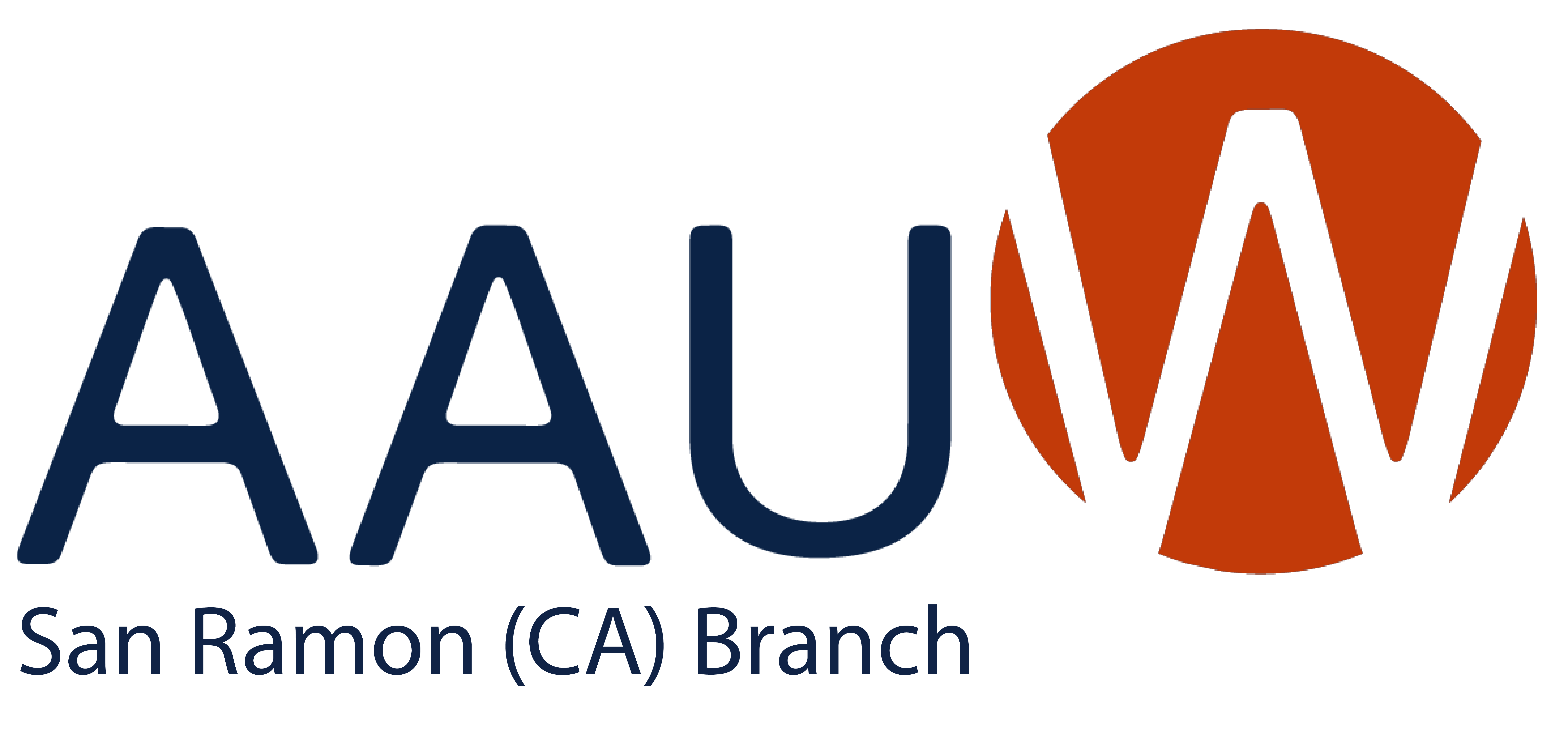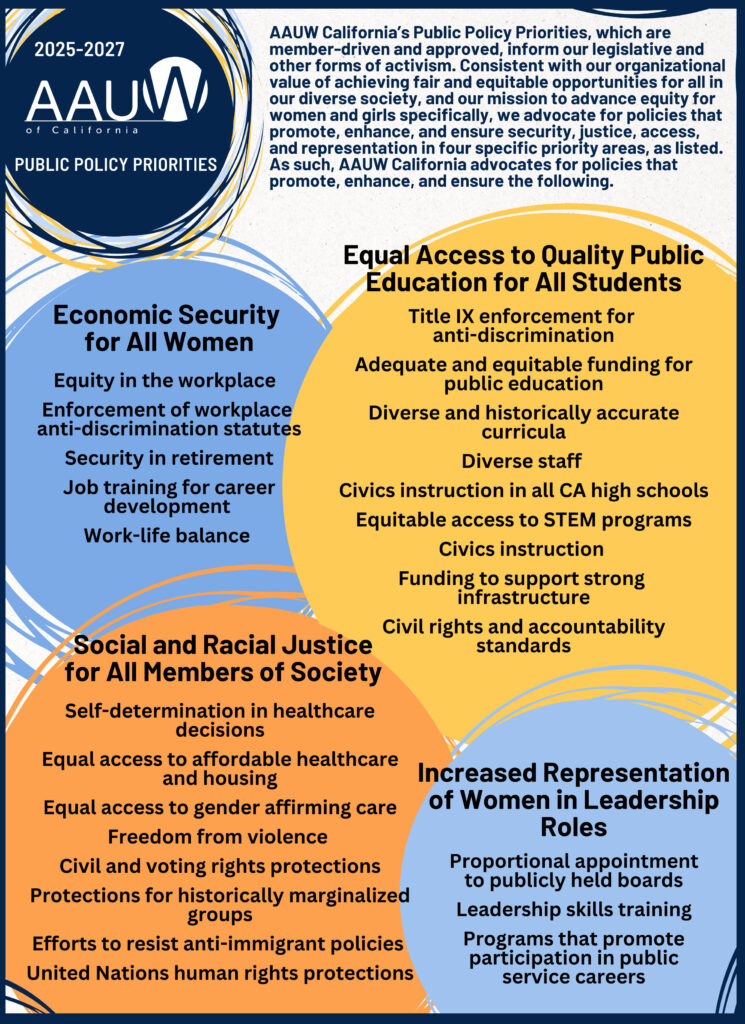AAUW Public Policy Principles & Priorities 2025–2027
AAUW 2025-2027 Public Policy Principles and Priorities PDF available here
AAUW’s mission to advance gender equity through research, education, and advocacy is grounded in these bold principles:
AAUW opposes all forms of discrimination on the basis of age, disability, race, ethnicity, sex, gender, sexual orientation, gender identity, geographical location, national origin, religious beliefs, pregnancy or parental status, or socioeconomic status, and supports constitutional protection for the civil rights of all individuals.
We Stand for Education
Higher Education: Support affordable, inclusive higher education that yields high-quality credentials or degrees; reduce barriers to completion; and address the student debt burden, especially for women and borrowers of color.
Public Education: Invest in strong public K–12 systems and oppose the use of public funds for nonpublic schools.
Inclusive Curriculum: Ensure curricula are accurate, science-based, and free from censorship or bias.
STEM Opportunities: Close the gender gap in STEM and expand access to vocational and technical training.
Strengthened Civil Rights Protections: Support safe, harassment-free learning environments by strengthening and enforcing protections to prohibit discrimination based on sex, race, and disability.
We Stand for Economic Security
Pay Equity: Ensure equal pay for work of equal value through salary transparency, fair wage laws, and anti-discrimination enforcement.
Support for Caregivers: Expand access to paid sick and family leave, and affordable child and elder care.
Retirement Security: Protect and strengthen Social Security, Medicare, and Medicaid.
Reproductive Freedom: Ensure access to contraception and abortion care.
We Stand for Social Justice and Civil Rights
Constitutional Rights: Vigorously enforce civil rights, including recognition and publication of the Equal Rights Amendment, and improve disaggregated data collection.
Expanding Voting Rights: Promote equitable political participation and ensure all Americans have full access and the right to vote.
Freedom from Harassment and Violence: Guarantee legal protections from harassment and gender-based violence, and support efforts to combat human trafficking and reauthorize the Violence Against Women Act.
International & Civil Rights: Support U.S. advancement toward gender equity in education and the economy through the Beijing Declaration and Platform for Action and ratification of CEDAW.
AAUW’s 2025–2027 Federal Action Priorities
To support equitable access to higher education—and to reduce the barriers that hinder women’s advancement, especially women of color—AAUW advocates for:
- Reinstating Title IX rules that strengthen and clarify protections for student survivors of sexual harassment and assault, ensure accommodations for pregnant and parenting students, and affirm protections based on sexual orientation and gender identity.
- Defending inclusive education from attacks on diversity, equity, and inclusion.
- Reducing barriers to post-secondary success, including increased financial support and manageable student debt.
- Addressing non-tuition barriers such as paid leave, childcare, and access to contraception, and abortion care.
Submitted by Catherine Lewis, AAUW San Ramon Public Policy Chair
New Resource for Taking Action!
Interactive and Living Spreadsheet
Presented by AAUW of California Public Policy
Source: AAUW California Public Policy News
To respond to the attack on the people and issues we care about, and to fulfill the mission of our organization, “to advance equity for women and girls through advocacy, education, and research,” we have continued to compile resources to help you take action to fight back. And, with the help of our amazing Public Policy Interns, we are finally able to launch an interactive resource that will provide you with action options.
Click HERE to access our new interactive and living Take Action spreadsheet.
This spreadsheet attempts to create a clearinghouse for ongoing resistance activity, so that you can follow and join in based on your passions and preferences. We also highlight successful political and legal actions, to give us both hope and a blueprint for moving forward. Click on QUICK ACTIONABLE ITEMS if you are looking for general action resources, LITIGATION & LEGISLATION TRACKERS if you want to keep track of advancing legislation and or legal challenges, and PODCASTS if you want to learn more and/or encounter even more “good trouble.” Click on ISSUE AREAS if you are looking for information and resources in a specific issue area. Please share this resource with anyone who you think will find it useful–inside or outside of AAUW California.
AAUW California Public Policy is On Bluesky
AAUW California Public Policy now has its own social media account–on BlueSky!
Join us in this social media space.
https://bsky.app/profile/aauw-ca-advocacy.bsky.social
We are just getting started, but we plan to use this account
to send out state-level legislative action alerts, promote Resistbot petitions, and provide real-time updates.
We encourage you to create your own account, if you have not yet done so, and follow us! You can find us by clicking the link above or by following us on Bluesky @aauw-ca-advocacy.bsky.social
For more resources on AAUW California Public Policy, please click here.
Submitted by
Catherine Lewis, Public Policy

